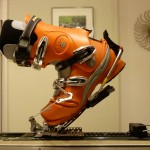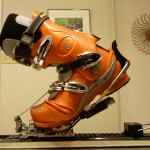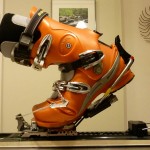The Nitty Gritty:
Activity:
How retentive is my home brewed TTS in terms of ball of foot (BOF) hold down, resistance to heel lift, etc.? Comparing the Dyna-Axl to the Hammerhead (HH), both outfitted with standard springs:
The activity level of the Dyna-Axl is not only more than I expected and more than a standard Axl, but the action is very smooth and comes on as soon as you lift the heel/push the cuff. I did not ski the Dyna-Axl with the pin removed, but in carpet tests it had a very neutral feel, on par with a Switchback or 7TM.
Touring Function:
In order to use the free pivot, the heel throw must be “stowed” behind the heel riser. This can be done with skis on by simply squatting down and flipping the lever off the heel, lifting the climbing bar, then slipping the heel throw over the back of the riser. The tech toe is a true free pivot, minimal resistance while skinning means less energy expended, getting in and out of the toe is as simple as flipping the release lever with a ski pole tip. A full 90° ROM for touring is available, even if you never really need that much.
Lateral heel displacement:
How far does the heel move across the ski under lateral pressure?
This is an area of concern voiced by many interested in TTS. At first glance it would seem that the tech fittings would be insufficient to contain the boot during a hard telemark turn, but this could be no further from the truth. I weigh 200#, driving mondo 30 boots, skiing very low and very fast. As an acknowledged binding breaker, you would think that I’d be blowing out of the toe on every turn, but after hundreds of turns I never had a wiggle. In truth, the tech fittings work in telemark for the same reasons they work in alpine touring, it’s a good design.
Durability:
Can the tech fittings and pins take the abuse day after day?
With TTS still in it’s infancy, I can’t say how long the fittings and pins will last before they wear out or fail, but in alpine skiing the tech system has proven itself durable over the years and has become the standard by which other lightweight AT bindings are compared. According to Mark Lengel, his TTS bindings have been skied for multiple seasons with no signs of excessive wear outside of what would be expected from AT use.
Release:
The Dynafit tech binding is a system binding designed with a simple pincer toe that relies on a heel piece for stability and to set both lateral and vertical release. TTS incorporates only the tech binding toe piece, so lacking the tech heel, there is not an adjustable release per se. In ski mode, without the heel engaged, the tech toe piece releases easily, hence my use of the binding in “locked mode” (touring). Lateral stability would seem to be a problem for TTS, but in reality the heel throw and spring assembly provide for some of the missing stability, though less than with a tech heel piece. In bench tests I found that the Dyna-Axl in ski mode (unlocked) would release laterally with about the same effort as a complete Dynafit binding set at a DIN 5. In locked mode the Dyna-Axl took more effort to release depending on the number of “clicks” that the toe piece was engaged, approaching DIN 10.
This short film clip shows the release function in ski mode ~ DIN 5:
In tour mode with the lever locked the release requires significantly more effort, ~ DIN 10.
There are tech bindings that have an adjustable release toe piece (La Sportive, ATK, Plum), but the cost for these bindings is double the Dynafits, so there’ll be no tests forthcoming for this budget garage tinker; plus my wife said no. That said, the Dynafit toe has an acceptable disaster release option for use in avy terrain or when protecting injury prone legs. Additionally, I found the Dynafit toe was quick to re-center when incompletely released, which is a nice trick in case you induce a partial release. I did not get the sense that the system would pre-release any more than other releasable telemark bindings, but I do believe that the release will be better and more reliable, especially in a twisting fall. I did not ski the binding unlocked since I did not want to release too easily.
Forward rotation and Retention Fade:
My early TTS set ups with the hardwires and spring cable wires did a good job of limiting forward rotation to the point where the boot was ~30 degrees to the ski, but beyond this point it seemed as though binding activity “went away”. In non-engineering terms; I am not an engineer, this seems to be due to the boot arc maximizing spring length early on (zero to 30 degrees), then as the boot continues forward past the peak of the boot arc, the optimal angle of retention is diminished and the springs become less capable of controlling rotation. In contrast, the Dyna-Axl provided continuous retention (activity) throughout the boot arc because the cables are continuously leveraged by the boot, providing a progressive feel, from heel to ski to knee to ski.
Cable Pivot point:
The real meat and potatoes of TTS, lots of variability here to optimize the feel. I can’t say enough about the three settings I adopted from the Axl, at 70mm, 80mm, and 90mm from the fulcrum to the tech pins. These settings provide the ideal mix for me as I could see using the third position for racing gates and carving, the middle position for all around skiing, and the first position for softer snow. There is also a zero position with the slick pin removed which I could see being useful for softer boots, smaller skiers, and Nordic styled skiing. What I did notice is that the “optimal” fulcrum position seems to vary depending on the retention system used, so a different spring assembly might need more or less distance between the pins and fulcrum to optimize activity.
In summary, I found that my Dyna-Axl variation of the Telemark Tech System works, and it works well. There remain issues to be resolved such as optimizing retention and fulcrum position, developing TTS specific tech toes that provide for adjustable release, and providing binding kits that allow a non technical person to assemble a telemark tech system. By utilizing the tech fittings, TTS avoids the complications inherent in having a toe and heel that are co-dependent, allowing for a multitude of retention options and a free pivot that is unencumbered by the means of retention.
It’s a sweet trick, that’s for sure 🙂
© 2011
Pages:
- 1
- 2




13 pings
Skip to comment form